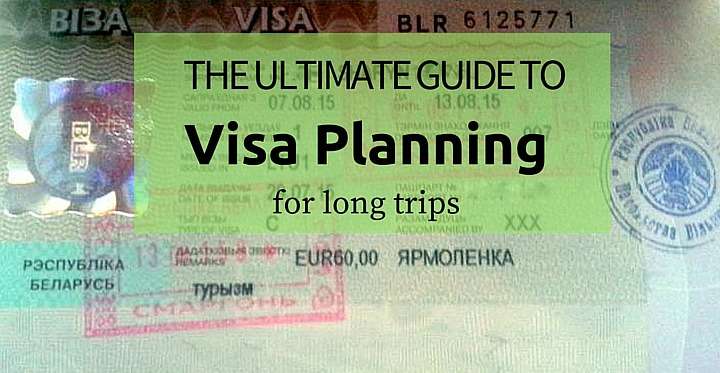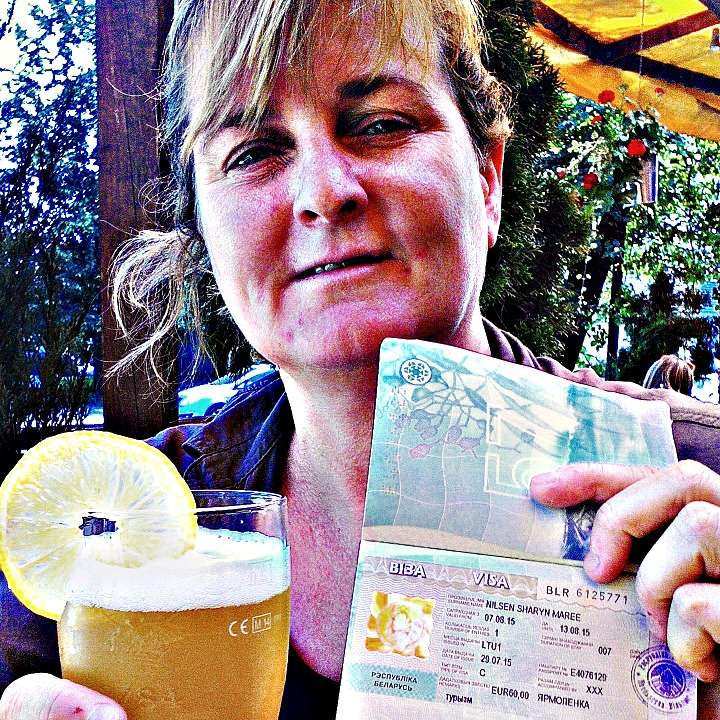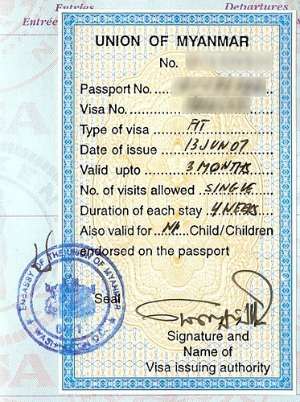Visa Planning for Long-Term Travel is [Insert colorful adjective here!]
Suggestions include – frustrating, exhausting, confusing, and a pain in the ass. If you’re a bit of a nutter like me, you might consider – challenging and fun.
One of the biggest headaches we have on our long-term adventures is visas. An Australian passport is one of the best in the world (https://www.passportindex.org/byRank.php), and as of 2016, we can enter 150 countries visa-free or with a visa on arrival. But that still leaves a lot of planning to do. I feel for those less fortunate. Our 2012 – 2013 trip journeyed through Asia across the Silk Route and then onto Africa. We entered 35 countries over a period of 15 months and required 25 visas costing over $4000 USD. Ouch! As you can imagine, the logistics were complicated. A few of those challenges included:
- Some countries (Ghana and China) would only issue us with the type of visa we wanted from their Consulate in Australia. That created a bit of an issue as we were living in Vietnam at the time. Luckily, we had plans to visit the folks before we set off! But, we weren’t visiting for long enough to obtain them in the standard time and had to express them at double the cost! We planned to transit straight through some places like Turkmenistan, but we wouldn’t have the time to get visas for countries further into the trip.
- We planned to transit to a few places like Turkmenistan to avoid onerous visa requirements. That meant we wouldn’t have the time to get visas there for countries later in the trip.
- We couldn’t get many of the visas too early, as they would expire before we got to the country in question. (We had to negotiate the validity on our Ghanaian visa up from a 3-month validity to 10 months)
- We had to get brand new passports because we couldn’t afford to change them along the way and forfeit visas we’d already obtained.
The moral of the story:
Don’t leave Visa planning for long term travel to the last minute. Want the FREE tool I developed to help us plan? – Click Here
Ways to Obtain a Visa
You can get a visa in several ways. Some are easy, and others are a right royal pain in the butt! Below are the three most common and a list of issues to consider.
1. Visa On Arrival (VOA)
Obtaining your visa as you enter a country is the easiest and most convenient method available. However, there are variations on requirements, and if you’re unaware, you might be refused entry and turned back—a whole world of hurt, especially if you’ve voided the visa from the country you just left.
Things to Check
- Some countries, such as Ethiopia, only allow VOA if you fly in, and there may be restrictions on what kind of visa you can obtain this way.
- Not all borders for a particular country have the authority or facilities to issue a VOA.
- Some countries require you to:
- Submit your application online beforehand,
- obtain and print a letter of approval, and
- present that at the border/airport to get the visa placed in your passport.
2. Obtain your visa in a third country
Unless they’re fighting, most countries will have embassies or consulates in others worldwide, especially their neighbors. If you’re traveling overseas, obtaining your visa in the country before you cross the border is usually the most convenient option. Unless:
- The visa application process takes longer than you want to spend in that country.
- The visa application process requires you to submit your passport, and you can’t travel within the country without it (e.g., Vietnam).
- The embassy or consulate in that country is known for making things harder or more expensive than other options.
- The embassy or consulate will only issue visas to citizens or permanent residents of their country.
3. Obtain your visa in your country of residence
This can be problematic or expensive if:
- You’re already on the road. (like us!)
- There isn’t an embassy or consulate in your home country. (Like us for many!)
- You live a long way from the location of the embassy or consulate. (Like us in our hometown in Oz!)
Getting Help
In all three options, you may choose OR require the services of a Travel Agent, specialist Visa Agency, or a “helper.” Depending on the circumstances, it may cost more, but it can save you a whole world of grief. However, it can also be dangerous if you don’t hire the right help. Beware of:
- There are fake websites that phish credit cards and personal details. (This happened to fellow passengers obtaining their Nigerian visas in England.)
- Fake visas (A problem in Vietnam in the past)
- Losing your passport in the mail (or to villains) during the process.
It ain’t easy, but…
I wish I could say there’s an easy way to get all your visas for a long-term trip. But I can’t unless you’re prepared to hand over your passport and a huge bucket of cash to an agent. Even traveling through Europe has its challenges unless you’re European. The Schengen region only allows the rest of us to stay for 90 days in every 180. That was quite a challenge on our recent bicycle tour through the area. And there are always a few anomalies to keep you on your toes. Our 2015 Caribbean trip was a case in point when we entered Puerto Rico on a private yacht. Usually, we could participate in the US Visa Waiver Program. But not in this instance. Arriving on a private vessel required us to obtain a B2 Visa, which meant a whole new level of bureaucracy. (Two weeks before we were due to set off from Vietnam!!) Free resources for visa planning on long-term trips #VisaPlanning #LongTermTravel Share on X
How to plan your visa acquisition strategy
First, I developed a spreadsheet to assist with our planning. Go ahead and grab a copy for FREE HERE. And use it as you go through the following process.
A list of the other resources mentioned at the end of this post is available.
Let’s get started.
Step 1. Where are you going?
- Make a list of the countries you plan to visit in the order you plan to visit. (Column A on the spreadsheet) Your initial itinerary may change based on information you gather down the track, but it’s a good starting point.
- If you have an approximate timeline for your trip, write down the dates (Columns B & C)columns), and
- Calculate your length of stay (column D). Make sure you count the day you enter and the day you exit. If you don’t have a clue, come back and fill these in as new information becomes available.
Step 2 Determine if you need a visa for each country.
It’s a simple yes or no in the first instance. This link to Visa Requirements for all countries is a good start, but I recommend you confirm from a secondary source. You can find A more comprehensive list of resources at the end of this post.
If No. Work out how long you can stay visa-free. Then ask:
“Is it enough time for what you want to do and see?”
If it is – Yay! Promptly perform a happy dance and move on to the next country on your itinerary.
If you’d planned to stay longer than allowed visa-free, you’d need to get a visa or change your itinerary. Perhaps you can exit to a neighboring country and return. However, some countries require you to stay out for a set period before returning, e.g. India and the Schengen Region.
If Yes, ie. you do need a visa, then….
Can you get your visa on arrival? (Column E)
The answer here will be Yes, No, or Maybe. ‘Maybe’ means only at some borders. That means you may have to fly in or enter a particular place to get one. Ask yourself – “Does that suit your plans?” If Yes, another happy dance is in order. At this rate, you’ll be exhausted.
Note: Always check the small print regarding:
- onward travel requirements,
- other documents you need to present,
- costs, and the currency you need to pay in. (Usually local money or USD)
Make a note (in your planning spreadsheet. Column X). If No (you can’t get a VOA), we’re now at the point where you need a visa and can’t get it on arrival.
So now you need to start asking the following questions:
Step 3 What kind of visa do you require?
Based on your itinerary:
- How many entries do you need? Single, Double or Multiple
- How long is each stay? It’s usually 30, 60, 90 days etc.
- If you want to stay longer than the visas on offer, are extensions available while you’re there? If so,
- How many extensions are you allowed, and for how long?
- How long will it take you to get an extension, and
- Where can you get the extension from? I remember friends trying to extend their 30-day visas in China. They were on bicycles. It took them half their 30 days to extend their visa, and the new one was activated immediately. They only gained around 15 days and had to remain in one place for far longer than they wanted to. Net gain – zero! They still had to get their bikes on a train and cut their trip short anyway.
NOTE: The number of entries and length of stay allowed may depend on which consulate is issuing the visa. For example, in 2012, if we obtained a Chinese visa in Australia, we could get a double entry for 60 days. If we obtained the visa in Kyrgyzstan, we would only be granted a single entry for 30 days.
Step 4. Find out the validity of the visa once you get it.
Your visa validity is the time between visa issuance and expiration date. Together with your arrival date, you can work out the best place to obtain your visa. If you don’t enter (and sometimes exit) the country before the expiration date, your visa will be void, and you’ll need to get a new one. Visa validity can be as little as one month. Thankfully, it can sometimes be negotiated. We successfully did this with our Ghanaian visa issued in Australia (3 months up to 10 months), and our American B2 Visa issued in Vietnam (3 months up to 10 Months)
Step 5. Are visas issued based on fixed dates?
Some visas are issued based on EXACT dates. You provide your entry and exit date, and your visa reflects this. However, you can usually arrive after the entry date and leave before it expires. But this kind of visa provides a whole new level of complexity when you are working out your itinerary. !#$%!*! Make sure you overlap the dates of neighboring countries so you don’t get stuck with one visa running out and not being able to enter the next country.
Step 6. What extra documentation is required?
Your visa application process will require extra documentation in the more bureaucratic countries. Examples include:
- A Letter of Invitation (LOI) from an official tour company,
- Confirmed accommodation bookings,
- Flights out or proof of onward travel,
- Country Specific Insurance (e.g. Belarus, Iran)
- Proof you can pay for your trip – bank statements
Some of these might be problematic if you’re going overland or don’t want to book a tour. Thankfully, some companies have filled the void to provide a workaround.
Letters of Invitation (LOI’s)
Companies that provide LOI’s without requiring a tour booking can often be found near the consulate (See our blog on obtaining Belarus visas in Vilnius). Otherwise, there are sometimes companies that can provide them online (E.g. Stantours for Iran, Russia, and Central Asia)
Accommodation Bookings
This can get tricky, especially if you want to move about a country and haven’t nailed down your itinerary. Having to book all your accommodation is a pain. Depending on the country, there may be limited options to be booked online without a financial commitment. Some countries only allow government-approved hotels, and they are usually expensive. Try Bookings.com, Agoda, and Hostelworld to start. You might get lucky and find a “No Credit Card required” option or free cancellation after you’ve entered the country. Print the confirmation and cross your fingers. If you have to pay a small, non-refundable deposit, getting the treasured entry stamp on your passport might still be worth it.
Proof of Onward Travel
This is another pain in the butt if you’re traveling overland. You might be able to book a bus or train ticket online from large companies, but you’ll be out of luck if you plan to take taxis or other local options.
There are a number of companies that now allow you to “rent” a flight ticket. is a new option that may be able to help out. They will provide you with international flight tickets (travel itineraries) with your name on them to use as proof of onward travel plans. The company purchases the ticket and then cancels it after an agreed time for a fixed cost. I’ve added several of these companies to the “Tickets Out/Onward Travel tab of Section 1 on our Flight resources page.
Note: there are some time limits to the cancellation period (24 hrs to a week), so you need to plan ahead how you’re going to access this service. You would be extremely unlucky for the consulate to check if your flight is still valid, but it might happen. we used this service to get our long-term visas for Thailand and bought an extended 7-day validity, just in case they did.
Country Specific Insurance
If you require country-specific insurance, your normal travel insurance won’t suffice! Iran and Belarus are two that come to mind. There will typically be a travel agent or official office near the consulate. The trick will be tracking it down and communicating your needs if there’s no English.
Proof You Can Pay for Your Visit
How much is enough? Occasionally, the consulate may ask you to prove you have enough money to support yourself during your visit.. Most times they don’t. Hopefully, you do have enough saved, and it’s just a matter of printing out a bank statement (Leave your name on it but black out account numbers and personal information). If not, you might need to ask trusting souls to transfer some cash, print the balance, and return it.
Step 7. Identify special permits or visas for particular regions of a country you want to visit.
Sometimes, a visa just isn’t enough. There may be exclusion zones. For example, a Chinese visa won’t get you into Tibet, and a Tajikistan visa won’t get you into the GBR region on the Pamir Highway. You need to go through a separate process for those. It is best to create another line on the spreadsheet and deal with these requirements separately.
Step 8. Identify whether you can obtain the visa in a third country (or only your own).
Paired with the validity, the requirement to go home to get your visa might make you rethink your itinerary. In fact, at this stage, your head might be about to explode and you’re about to cancel the trip altogether!
In fact, at this stage, your head might be about to explode and you’re about to cancel the trip altogether!
C’mon. This is fun.
Step 9. Identify the best place to get your visa.
You should now have most, if not all, of the information required for the visas you need. It’s now time to identify where you can get them. While you may prefer to obtain your visas before you leave home, that might not be possible, convenient, or cost-effective. It also limits your flexibility, especially if dates for entry are fixed on the visa.
If possible, we try and obtain our visas in the adjacent country. But we always have a plan B. This part of the process can be tedious. Surprisingly, many embassy and consulate websites are poorly maintained, usually because they are badly designed in the first place. Links don’t work; information is old and often hard to find in multi-layered navigation systems. There is no one process page, and you need to jump all over the place to find the complete story.
Three resources and a Google search.
Despite much searching, I’ve yet to find a fully comprehensive tool. Quite often, listings will show the main embassy in the capital city and neglect to mention other, more convenient locations. Embassy Pages, Embassy Worldwide, and Embassy Finder don’t do a bad job and show many consulate and embassy locations worldwide. Unfortunately, none of them appears fully comprehensive. Check at least two and compare.
The information does change, so validate what you find by tracking it through individual government websites (not always possible). Visa information is typically found under the “Consular” section of the site if it’s not immediately apparent.
Also, note that the consular services may be in a different building (sometimes a different neighborhood) than the Embassy. Eg. The Ukraine representation in Vilnius!! Of course, you can always search for the [Country you’re visiting] consulate in [Country you’d prefer to get your visa in] And see what you come up with. Nine times out of ten, it will be one or more of the three resources above at the top, and you’ll have to drill deep to find anything different. Stick With It. You’ll get there in the end.
Step 10. Choosing which place is best
Identify two or three choices
Once you’ve verified that there is a consulate in countries adjacent to the country you want the visa for, identify your first choice (Apply Option 1 in the spreadsheet) and a backup plan (Apply Option 2). You might even consider investigating an extra one to be super safe and give yourself even more flexibility.
The following considerations will guide your final options.
Which of the consulates will accept your application?
Some consulates only process visas for residents. If you’re passing through, you won’t get one.
When can you apply for and receive your visa?
Identify days and times for visa application submissions and pick up, AND how long they take to issue. Do they quote calendar days or business days? How does that fit in with your proposed itinerary? Ideally, you should plan to arrive in the city the day before you submit the application to minimize the time you’ll need to spend there. If visa applications are only accepted on Tuesdays and Thursdays and take five working days to process, arriving on a Friday will extend your stay by four days. So, rather than a week, you’ll need to stay 11 days.
Are there any special requirements at each Consulate?
Note any special requirements – documentation requirements, security protocols, photograph specifications and add the information to your notes.
Are any of the choices particularly difficult?
Perform a quick search of blogs and forums to identify common problems or issues with each particular consulate. Unhelpful staff, disorderly lines, high refusal rates, and a history of losing documents are all good reasons to change your choice.
Step 11. Reassess your itinerary
Wheeew!!
OK, you have as much information as you can muster. You’ve got a pretty good handle on costs. You know where you’re likely to be stuck waiting for visas and the best strategy to complete the process in the shortest possible time.
How does it look?
Do you need to change the order of the countries you visit?
Do you need to deviate from your original path to pick up a visa?
Will it be possible to get the visa in the time you have? And therefore, do you have to fly over or go around this time? This happened to us on our 2015 European cycling adventure. We were running out of Schengen days. The Ukrainian consulate in Vilnius wanted 10-15 working days for a standard visa or double the price to process them in 5. It was cheaper for us to fly the bikes OVER Ukraine to Moldova than to pay for the faster processing time. And we preserved our precious Schengen days to spend more time at our final destination, Hungary. It was disappointing, but it was the best choice for us at the time.
A few extra tips to make getting your visa as painless as possible.
- Identify all document and photo requirements before you go to the consulate. Download and fill out as much of the documentation as you can. If you need special insurance (e.g., Belarus and Iran), work out where and how to obtain it. Sometimes, you won’t know this until you start the application process.
- Dress up (as best as possible). I know some travelers who’ve been refused visas because they turned up looking scruffy, unkempt, and unshaven. But wear comfortable shoes. You could be waiting for a while.
- Arrive as early as possible. 30 minutes to an hour before opening time is a good rule of thumb. You’ll often find “placeholders” there before you. We have been at consulates that were an absolute bunfight!! Queue jumpers, especially agents with multiple passports, can considerably extend your wait time. The closer you can get to the front of the queue, the better, especially if applications can only be submitted in a short window of time. The Mongolian embassy in China and the Mauritanian embassy in Morocco are two particularly frustrating examples.
- Take weather protection – an umbrella, sunscreen, a hat, water (and a strong bladder!). Very few consulates will allow you to line up inside the complex. You are normally lined up on the pavement, and there are rarely seats or shelter.
- Be calm, patient, and polite at all times, even if the official is giving you a hard time. Even if you meet all the criteria, they are not obligated to provide you with a visa. Being an official in many countries is one big power trip. A smile and a bit of groveling go a long way.
- Check all the details on the visa – WHILE you are still in the consulate. Dates, number of entries, personal details. EVERYTHING! It’s too late to change things once you’ve left.
The “Easy way”?
I did say at the beginning that obtaining visas for a long, multi-country trip wouldn’t be easy. Even when you have the visa, you may have to undertake special registration processes once you enter a country. That’s another story for another day. But there are ways you can smooth the path.
- You could engage a Visa Specialist where possible. It will be pricey but (perhaps) more convenient! You will still have visa expiration date issues, but they might be able to sort them out for you. IVISA is one such specialist.
- Go on a tour. They may not arrange everything for you but will have the latest advice. And, provided they’re an officially recognized company, they will be able to:
- Provide a LOI,
- Meet your onward travel and confirmed accommodation obligations and
- Facilitate the process while you’re on the road. We took an overland truck with African Trails through West Africa, which solved our onward travel requirements and left most of the visa coordination with the company representative. You can find a few of the companies we recommend on our Tours & Tickets Resources Page—Section 1, Extended Tours.
- Go Around. Of course, you can simply avoid countries where you need a visa. There are plenty more places to see. We skipped Bulgaria, Romania, and Hungary in the late nineties as the visa requirements were too onerous for us at the time. (We no longer need a visa for these countries and swung on through during our most recent cycling trip.) Personally, we have always found the effort to be worth it. Central Asia, Africa, Central America, and the Middle East are fascinating destinations.
Extra Resources
Country-Specific Visa Requirements
Visa requirements for American Citizens
https://en.wikipedia.org/wiki/Visa_requirements_for_United_States_citizens https://travel.state.gov/content/visas/en/general/americans-traveling-abroad.html http://cibtvisas.com/visa-quick-check
Visa Requirements for UK Citizens
https://en.wikipedia.org/wiki/Visa_requirements_for_British_citizens https://www.gov.uk/foreign-travel-advice http://visacentral.co.uk/visa-quick-check
Visa Requirements for European Union Citizens
https://en.wikipedia.org/wiki/Visa_requirements_for_European_Union_citizens http://wikitravel.org/en/Visa_Summary_for_EU_citizens
Visa Requirements for Australian Citizens
https://en.wikipedia.org/wiki/Visa_requirements_for_Australian_citizens http://dfat.gov.au/travel/visas/pages/visas-for-australians-travelling-overseas.aspx http://visalink.com.au/visa-quick-check#K
Visa Requirements for New Zealand Citizens
https://en.wikipedia.org/wiki/Visa_requirements_for_New_Zealand_citizens https://embassy-finder.com/travel-with_new-zealand_passport
Visa Requirements for Canadian Citizens
https://en.wikipedia.org/wiki/Visa_requirements_for_Canadian_citizens https://travel.gc.ca/travelling/documents/visas https://www.visahq.ca/visas.php#linkA
A handy tool to stay on track in the Schengen Regions in Europe.
This one we used for our cycling trip through Europe. It’s FREE and pretty easy to use. There are other paid apps but this one has the best reviews. Android version –>> Check Schengen Visa (IOS version HERE.)
Proof of Onward Travel.
Go to the “Tickets Out/Onward Travel tab of Section 1 on our Flight resources page.
Letters of Invitation
Stantours (Iran, Russia, and Central Asia)
There you go……..
We hope this post and our Visa Planning Spreadsheet are valuable to you. (Click here to get your copy if you haven’t already.)
Sorting out your visas is just one part of ensuring your dream trip goes smoothly.
What are your tips for reducing visa hassle?
How can we improve this post? Let us know in the comments below.











